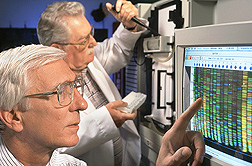Yeasts Produce “Green” Surfactants
Surfactants, wetting agents that lower a liquid’s surface tension, have a long list of uses—from detergents and cosmetics to paints and pesticide formulations. Annually, about 10 million tons of surfactants are produced; most of these are petroleum based and rely on limited supplies of fossil fuels.
To develop a renewable alternative, an Agricultural Research Service team in Peoria, Illinois, has begun focusing increased attention on the properties of sophorolipids, surfactant-like molecules produced by naturally occurring yeasts. In 2010, for example, microbiologist Cletus Kurtzman and colleagues at ARS’s National Center for Agricultural Utilization Research in Peoria set their sights on Starmerella, conducting the largest survey yet of yeasts belonging to this taxonomic group.
Using phylogenetic analysis and mass-spectrometry, the team screened 19 of the 40 known Starmerella members for their ability to produce sophorolipids. Phylogenetics, which traces the evolutionary relationships between species or groups of organisms, was particularly useful because it enabled the team to determine which members produce sophorolipids based on shared gene sequences for the trait. Of particular interest were certain Candida species that were shown to be asexual members of the genus Starmerella.
Only a few Candida species had previously been shown to make the surfactants—most notably, C. bombicola and C. apicola, when fed various agricultural byproducts in lab experiments. To broaden the search, the team tapped the ARS (microbial) Culture Collection, an extensive repository maintained at the Peoria center’s Bacterial Foodborne Pathogens and Mycology Research Unit (BFPMRU).
In studies there, the team cultured the Starmerella yeasts on a diet of glucose (a simple sugar), or oleic acid (a fatty acid in, for example, soybean oil). They then measured the microbes’ sophorolipid production levels over a 24- to 168-hour period using mass-spectrometry analysis, which can identify compounds by their unique molecular weights.
As initially expected, C. bombicola and C. apicola boasted the highest sophorolipid yields. But these weren’t the only ones: The team’s analyses also turned up three other high-producing yeasts, including a completely new species known only as “Candida NRRL Y-27208,” which will be the subject of further investigation.
The findings add to a short list of candidate yeasts with potential for use in fermentation-based methods of mass-producing sophorolipids as green alternatives to petroleum-derived surfactants. “Yields from this study are good, and I am sure they could be enhanced markedly in scale-ups,” says Kurtzman. He and colleagues in the ARS Renewable Products Technology Research Unit—chemist Neil Price, laboratory technician Karen Ray, and chemist Tsung-Min Kuo (deceased)—reported their work in FEMS Microbiology Letters.
The team’s work also advances BFPMRU’s mission of preserving, characterizing, and ensuring genetic diversity in microbial specimens submitted to the microbial culture collection, which currently numbers 95,000 strains. “This project is also an interesting example of using phylogeny to predict the occurrence of a particular biochemical property in an organism,” Kurtzman adds.—By Jan Suszkiw, Agricultural Research Service Information Staff.
This research is part of Plant Genetic Resources, Genomics, and Genetic Improvement, an ARS national program (#301) described at www.nps.ars.usda.gov.
To reach scientists featured in this article, contact Jan Suszkiw, USDA-ARS Information Staff, 5601 Sunnyside Ave., Beltsville, MD 20705-5129; (301) 504-1630.
"Yeasts Produce “Green” Surfactants" was published in the July 2011 issue of Agricultural Research magazine.







